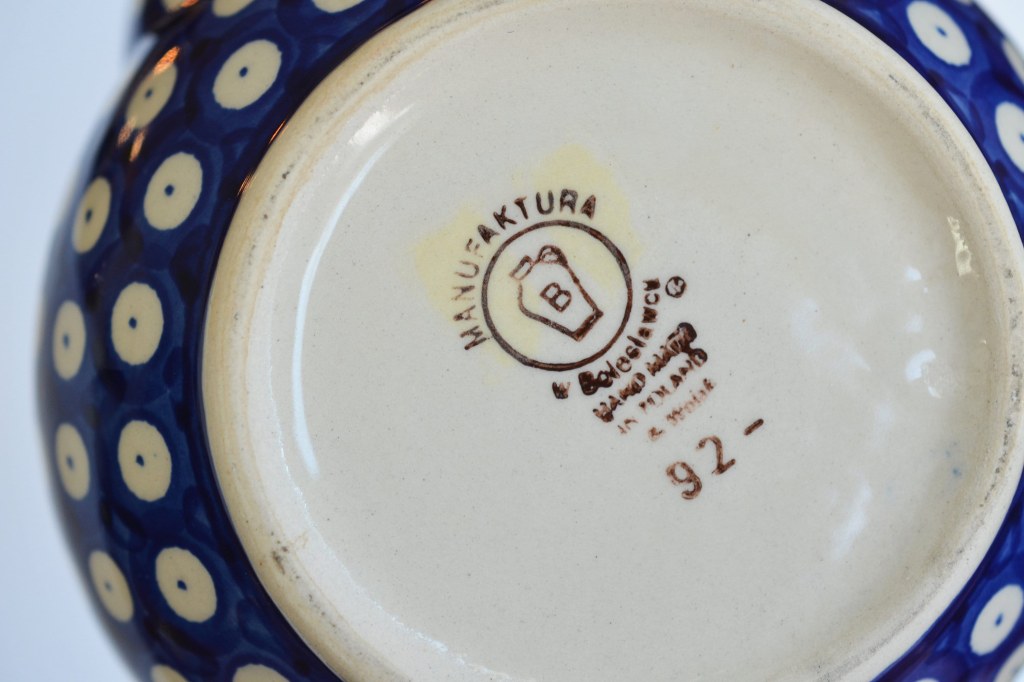Discover The Allure Of Polish Pottery Marks: Unveiling The Exquisite Beauty And History
Polish Pottery Marks: Unraveling the Mystery Behind the Art
Introduction
Welcome, Pottery lovers! In the fascinating world of pottery, one cannot help but be captivated by the intricate designs and timeless beauty of Polish pottery. Among the many aspects that make Polish pottery unique, the presence of pottery marks serves as a vital clue for enthusiasts and collectors alike. These marks not only authenticate the pieces but also provide valuable insights into their origins, history, and craftsmanship. In this article, we will dive deep into the world of Polish pottery marks, unraveling their significance and shedding light on the secrets they hold.
So, if you’re an avid Pottery enthusiast or simply curious about this captivating art form, join us as we embark on a journey to discover the hidden stories behind these mesmerizing Polish pottery marks.
3 Picture Gallery: Discover The Allure Of Polish Pottery Marks: Unveiling The Exquisite Beauty And History
What Are Polish Pottery Marks? 🎨
Polish pottery marks are distinctive symbols or signatures that are imprinted, painted, or stamped on Polish pottery pieces. These marks serve as a form of identification, allowing collectors and enthusiasts to trace the origins of the pottery, determine its age, and recognize the specific pottery artist or manufacturer who created it.
Understanding the Origins

Image Source: pinimg.com
The tradition of marking pottery dates back centuries in Poland. It began as a way for potters to distinguish their work from that of others, ensuring recognition and protecting their artistic creations. Over time, the marks evolved, becoming more intricate and varied, reflecting the unique styles and techniques employed by different pottery centers in Poland.
Decoding the Symbols
Polish pottery marks come in various forms, including initials, logos, symbols, and even signatures. Each mark carries its own meaning and tells a story. Some marks indicate the pottery center or region where the piece was made, while others denote the specific pottery artist or manufacturer. By deciphering these symbols, collectors can gain valuable insights into the piece’s history, rarity, and value.
Notable Polish Pottery Centers
Poland has several renowned pottery centers that have contributed to the rich tradition of Polish pottery. Bolesławiec, Bunzlau, and Cmielow are just a few examples. Each center has its own unique style and distinct pottery marks, making it even more intriguing for collectors to unravel the origins and stories behind their cherished pieces.
Exploring the History
The history of Polish pottery marks is intertwined with the tumultuous events that shaped Poland over the centuries. From royal patronage to political struggles, the marks bear witness to the triumphs and tribulations of the Polish people. By delving into the history behind these marks, collectors gain a deeper appreciation for the artistry and resilience of Polish potters throughout the ages.
Preserving the Legacy

Image Source: etsystatic.com
Today, Polish pottery marks continue to play a significant role in the world of pottery. They not only provide valuable insights for collectors and enthusiasts but also contribute to the preservation of Polish cultural heritage. By recognizing and cherishing these marks, we ensure that the artistry and craftsmanship of Polish pottery endure for generations to come.
Who Creates Polish Pottery Marks? 🎨
The creation of Polish pottery marks involves a collaboration between skilled pottery artists and manufacturers. These individuals possess a deep understanding of the craft and the history behind each mark. The artists meticulously design and execute the marks, while the manufacturers ensure that they are correctly imprinted or stamped onto the pottery pieces.
The Role of Pottery Artists
Pottery artists are the creative minds behind the intricate designs and symbols that adorn Polish pottery marks. They carefully craft each mark, considering its historical significance and the overall aesthetic of the piece. These artists draw inspiration from traditional Polish motifs, nature, and their own artistic vision, infusing each mark with unique character and charm.
The Expertise of Manufacturers

Image Source: pinimg.com
To bring the pottery marks to life, manufacturers play a crucial role. They possess the technical know-how and precision required to accurately transfer the marks onto the pottery pieces. Whether through stamping, painting, or imprinting, the manufacturers ensure that the marks are faithfully reproduced, preserving their authenticity and ensuring their longevity.
A Harmonious Collaboration
The collaboration between pottery artists and manufacturers is a harmonious dance of artistry and technical skill. It is their joint efforts that enable the creation of Polish pottery marks, turning each piece into a work of art with a story to tell.
When Were Polish Pottery Marks First Used? 🎨
The use of Polish pottery marks dates back centuries, with their origins intertwined with the development of pottery in Poland. While the exact timeline is difficult to trace, pottery marks became more prevalent during the 18th and 19th centuries.
The Rise of Pottery Marks
During the 18th century, the popularity of pottery began to soar in Poland. As demand increased, potters sought ways to distinguish their work from that of their competitors. Pottery marks emerged as a solution, allowing potters to proudly sign their creations and ensure recognition for their craftsmanship.
Evolution and Variations
Over time, Polish pottery marks evolved, becoming more intricate and diverse. Potters from different regions and centers developed their own unique styles and symbols, further enriching the world of Polish pottery. Today, the marks act as a visual timeline, reflecting the changing trends and influences that shaped Polish pottery throughout history.
Modern-Day Polish Pottery Marks
Even in the modern era, the tradition of marking pottery continues in Poland. Contemporary pottery artists and manufacturers honor this rich heritage by incorporating their own unique marks onto their creations. These marks pay homage to the past while reflecting the artists’ individual styles and interpretations of Polish pottery.
Where Can Polish Pottery Marks Be Found? 🎨
Polish pottery marks can be found in various locations on the pottery pieces, depending on the preferences of the pottery artist or manufacturer. The most common locations for marks include the bottom of plates, bowls, and mugs, as well as the handles or sides of larger pieces.
Bottom Marks
Many pottery pieces feature marks on the bottom surface. These marks are often imprinted or stamped directly onto the clay, providing a permanent and visible record of the pottery’s origin and maker. Collectors often turn the pottery upside down to examine these marks, as they hold valuable clues about the piece’s history and authenticity.
Handle or Side Marks
Some pottery pieces, particularly larger ones like vases or jugs, may bear marks on their handles or sides. These marks are designed to be aesthetically pleasing while still providing the necessary information about the pottery’s origin. They add an extra element of charm to the piece while subtly showcasing the skill of the pottery artist.
Hidden Marks
Occasionally, pottery artists incorporate hidden marks into their designs. These marks are not immediately visible but can be discovered upon closer inspection. The presence of hidden marks adds an element of intrigue and surprise for collectors, encouraging them to explore the piece more thoroughly.
Online Resources
In addition to examining the actual pottery pieces, online resources can be a valuable tool for identifying and understanding Polish pottery marks. Websites, databases, and forums dedicated to Polish pottery provide extensive information, images, and discussions about various marks, helping collectors unravel the mysteries hidden within these symbols.
Why Are Polish Pottery Marks Important? 🎨
Polish pottery marks hold immense importance for collectors, enthusiasts, and anyone fascinated by the world of pottery. These marks offer a multitude of benefits, both practical and sentimental, that enhance the overall experience of collecting and appreciating Polish pottery.
Authentication and Verification
One of the primary purposes of Polish pottery marks is to authenticate and verify the pottery pieces. By examining the marks, collectors can ensure the pieces they own are genuine and not imitations or replicas. This authentication provides peace of mind and allows collectors to confidently showcase their collections.
Origin and History
Each mark tells a unique story about the pottery’s origin and history. By decoding these symbols, collectors gain insights into the specific pottery center, artist, or manufacturer responsible for the piece. This knowledge adds depth and richness to the collection, fostering a deeper connection with the artistry and heritage of Polish pottery.
Rarity and Value
Polish pottery marks play a crucial role in determining the rarity and value of a piece. Collectors and enthusiasts can use the information provided by the marks to assess the scarcity of certain styles, artists, or periods. This understanding guides collectors in making informed decisions when acquiring or trading pottery pieces.
Preservation of Cultural Heritage
Polish pottery marks embody the cultural heritage and artistic traditions of Poland. By recognizing and cherishing these marks, collectors and enthusiasts contribute to the preservation and promotion of Polish cultural heritage. Each mark becomes a tangible link to the past, ensuring that the legacy of Polish pottery continues to thrive.
An Unforgettable Story
Every piece of Polish pottery marked with a unique symbol carries its own story. The marks serve as a testament to the skilled hands that shaped the piece, the history it has witnessed, and the journey it has undertaken. Collectors who delve into the world of Polish pottery marks embark on a captivating adventure, discovering the untold stories hidden within their cherished pieces.
How Can One Decipher Polish Pottery Marks? 🎨
Deciphering Polish pottery marks can be an exciting and rewarding endeavor for collectors and enthusiasts. While it may seem daunting at first, a few key strategies can help unravel the secrets behind these captivating symbols.
Research and Study
The first step to deciphering Polish pottery marks is to conduct thorough research and immerse oneself in the world of Polish pottery. Explore books, online resources, and forums dedicated to Polish pottery marks to gain a comprehensive understanding of the various symbols, artists, and manufacturers. The more knowledge acquired, the better equipped collectors will be to interpret the marks accurately.
Consult Experts and Collectors
Seeking guidance from experts and experienced collectors can significantly assist in deciphering Polish pottery marks. Engage in conversations, attend pottery fairs or exhibitions, and connect with individuals who possess extensive knowledge and expertise. Their insights and advice can offer valuable perspectives and shortcuts in understanding the marks.
Compare and Contrast
Collectors can enhance their understanding of Polish pottery marks by comparing and contrasting different pieces. Examine marks from various pottery centers, artists, and time periods. Note the similarities and differences in style, motifs, and execution. This comparative analysis can unveil patterns and trends, enabling collectors to make informed interpretations.
Purchase Trusted Reference Materials
Investing in reliable reference materials, such as books or catalogs dedicated to Polish pottery marks, can be an invaluable resource for collectors. These references often provide detailed descriptions, images, and explanations of various marks, serving as a handy guide during the deciphering process.
Visit Pottery Centers and Workshops
Immersing oneself in the environment where Polish pottery is created can offer invaluable insights into the marks. Visiting pottery centers or workshops allows collectors to witness the artistic process firsthand and gain a deeper appreciation for the marks’ significance. Additionally, engaging with pottery artists and manufacturers provides opportunities to learn directly from the experts.
Advantages and Disadvantages of Polish Pottery Marks 🎨
Advantages
1. Authentication: Polish pottery marks provide a reliable way to authenticate the origin and validity of pottery pieces.
2. History and Heritage: The marks carry the rich history and cultural heritage of Poland, adding value and significance to the pieces.
3. Rarity and Value: The presence of specific marks can indicate the rarity and value of a piece, guiding collectors in making informed decisions.
4. Artistic Appreciation: Deciphering the marks allows collectors to develop a deeper appreciation for the artistic techniques and styles employed by different artists and centers.
5. Storytelling: Each mark tells a story, and uncovering its meaning adds an element of intrigue and enchantment to the collection.
Disadvantages
1. Complexity: Deciphering Polish pottery marks can be a complex and time-consuming process, requiring extensive research and expertise.
2. Limitations: Not all pottery pieces bear distinguishable marks, making it challenging to trace their origins or identify the artists.
3. Reproductions and Forgeries: The presence of marks does not guarantee authenticity, as reproductions and forgeries can replicate them. Collectors must exercise caution and rely on expert guidance to avoid counterfeit pieces.
4. Fading or Damage: Over time, marks may fade or become damaged, making it more challenging to decipher or appreciate their significance.
5. Subjectivity: Interpretation of marks can vary, and certain symbols or designs may have multiple meanings or be open to individual interpretation. Collectors must consider multiple perspectives and rely on reputable sources for accurate interpretations.
Frequently Asked Questions (FAQs) 🎨
1. Can Polish pottery marks be faked or imitated?
Yes, it is possible for marks to be reproduced or imitated. To ensure authenticity, collectors should rely on reputable sources, expert advice, and thorough research.
2. Are all Polish pottery marks unique to specific artists or manufacturers?
No, while some marks are specific
This post topic: Pottery



